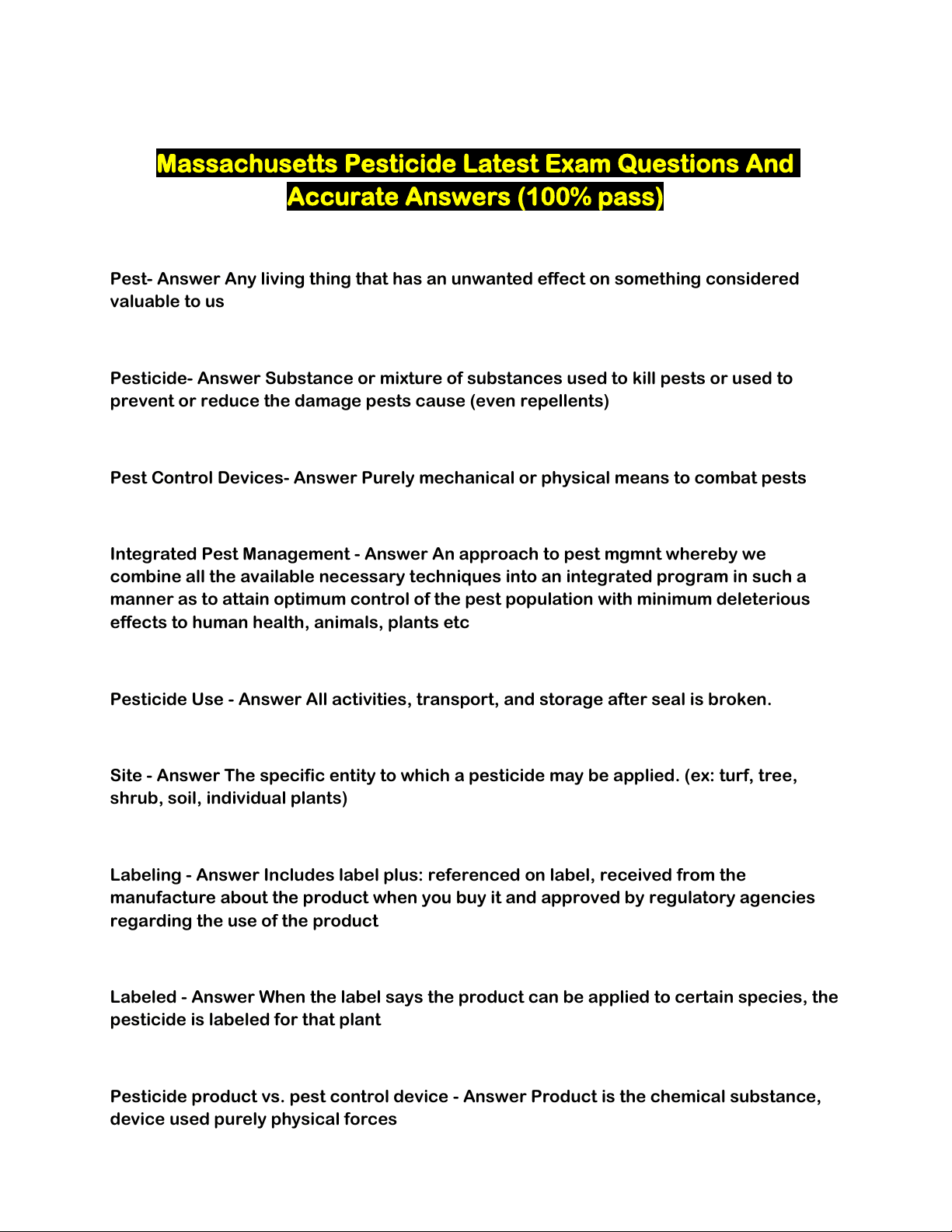
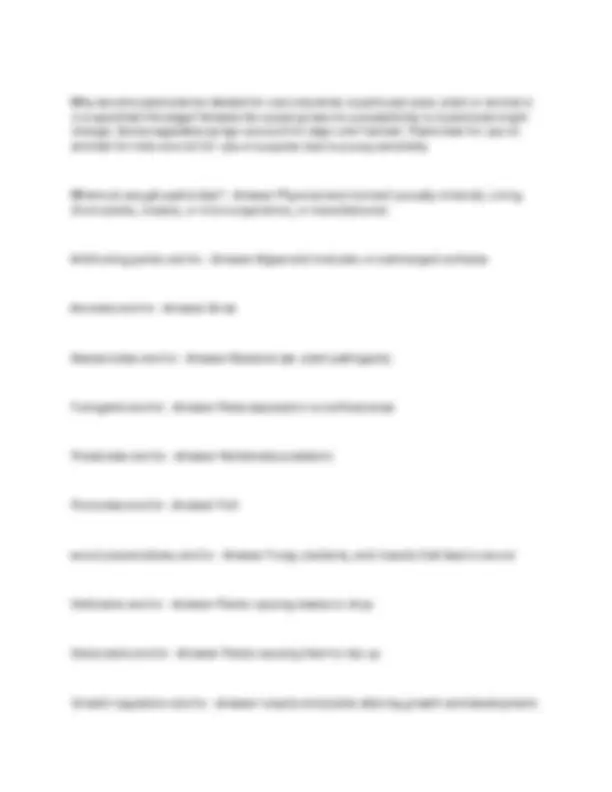
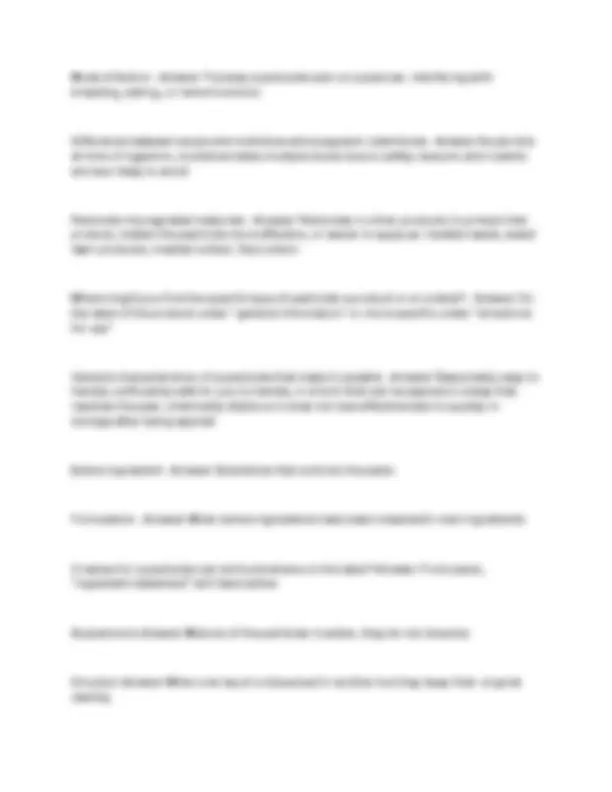
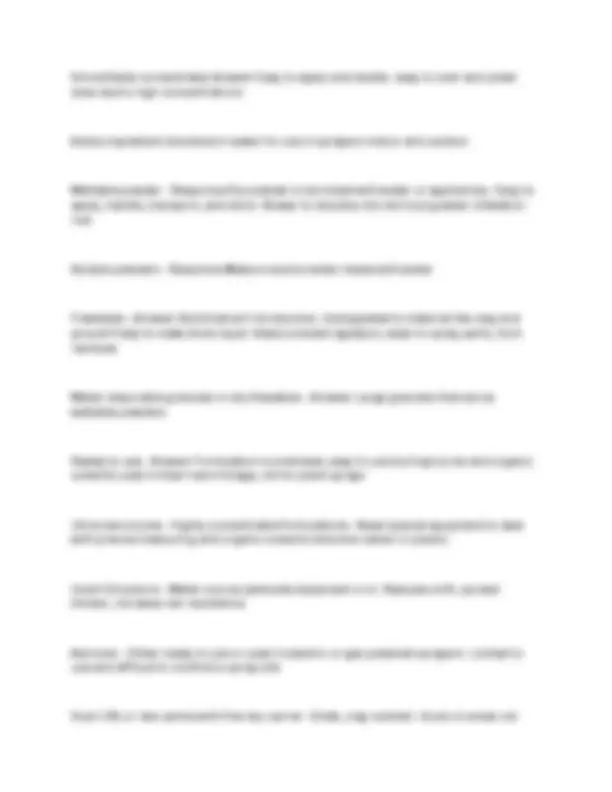
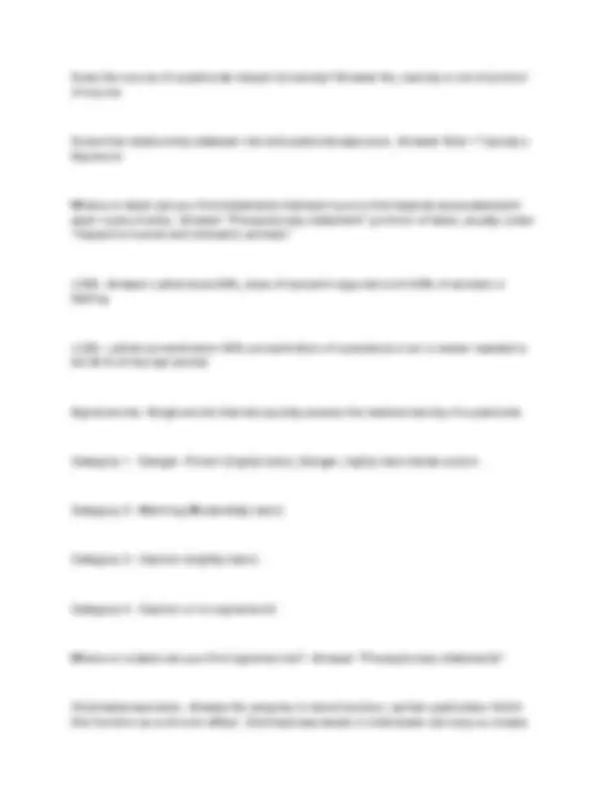
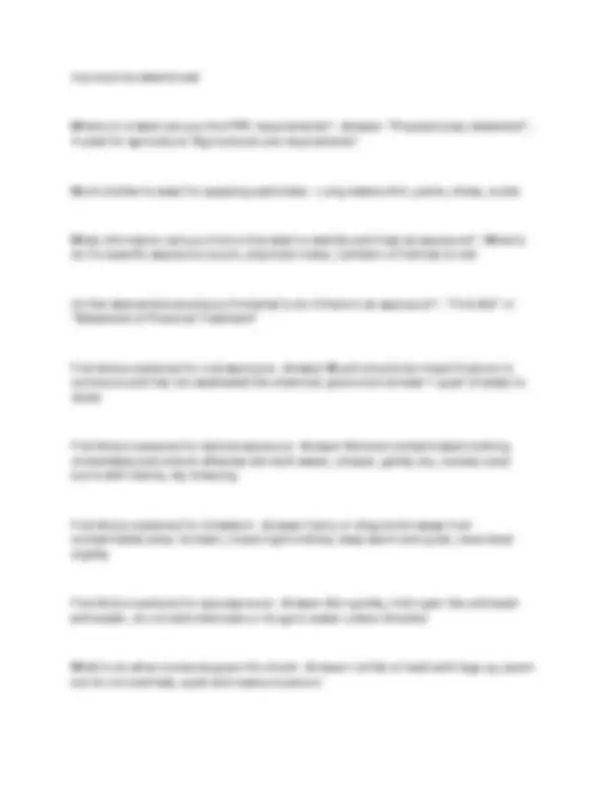

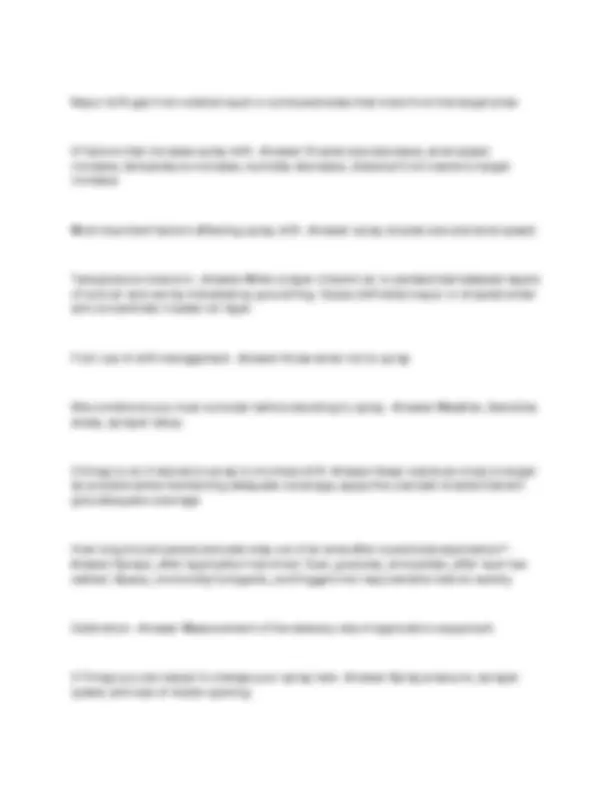
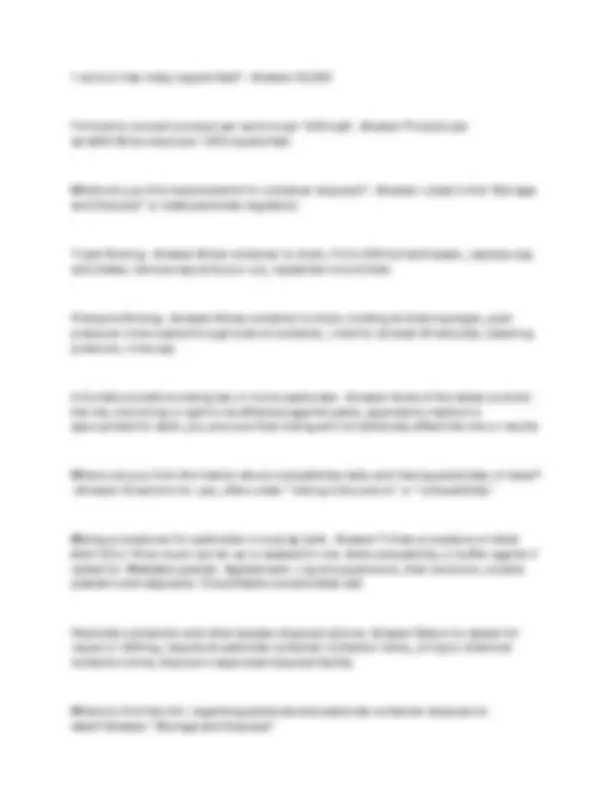



Study with the several resources on Docsity

Earn points by helping other students or get them with a premium plan


Prepare for your exams
Study with the several resources on Docsity

Earn points to download
Earn points by helping other students or get them with a premium plan
Community
Ask the community for help and clear up your study doubts
Discover the best universities in your country according to Docsity users
Free resources
Download our free guides on studying techniques, anxiety management strategies, and thesis advice from Docsity tutors
A set of exam questions and answers on pesticide use and safety, focusing on definitions, regulations, and best practices. It covers pesticide types, application methods, and safety protocols, making it valuable for certification or understanding pesticide management. The question-and-answer format facilitates quick learning and retention. Designed to help users pass exams related to pesticide application and safety, ensuring they are well-versed in pest control. Useful for students and professionals in agronomy, horticulture, and environmental science, offering insights into pesticide use. It addresses label directions and potential hazards, promoting responsible use and environmental stewardship. A valuable tool for anyone in pest management, providing a foundation in pesticide knowledge and safety.
Typology: Exams
1 / 15

This page cannot be seen from the preview
Don't miss anything!










Pest- Answer Any living thing that has an unwanted effect on something consideredvaluable to us
Pesticide- Answer Substance or mixture of substances used to kill pests or used toprevent or reduce the damage pests cause (even repellents)
Pest Control Devices- Answer Purely mechanical or physical means to combat pests Integrated Pest Management - Answer An approach to pest mgmnt whereby wecombine all the available necessary techniques into an integrated program in such a manner as to attain optimum control of the pest population with minimum deleteriouseffects to human health, animals, plants etc
Pesticide Use - Answer All activities, transport, and storage after seal is broken. Site - Answer The specific entity to which a pesticide may be applied. (ex: turf, tree,shrub, soil, individual plants)
Labeling - Answer Includes label plus: referenced on label, received from themanufacture about the product when you buy it and approved by regulatory agencies regarding the use of the product Labeled - Answer When the label says the product can be applied to certain species, thepesticide is labeled for that plant
Pesticide product vs. pest control device - Answer Product is the chemical substance,device used purely physical forces
Why do you have to follow the directions on the label - Answer Contains informationnecessary to effectively and safely use the product. It is illegal to go against the directions on the label Four basic survival needs which bring pest into conflict with people - Answer Food,water, shelter, reproduction sites
No metamorphosis - Answer almost no change besides size Life stages for no metamorphosis - Answer Egg, young adult (no wings) Life stages for gradual metamorphosis - Answer egg, nymph (with multiple instars),adult
Life stages for complete metamorphosis - Answer egg, larva (with multiple instars),pupa, adult
Annual weed life cycles - Answer grow from seed, mature, produce from seed, and diein one year or less
Weeds have one of three life cycles. Biennial weed life cycles Two year life cycle: first;grow from seed and develope heavy roots and rosette (heavy cluster of leaves). second; mature, produce seed, and die Perennial weed life cycles Can be produced by seed or re-sprout vegetatively; canspread by seed or root or stem cuttings
Where on the label could you find which pests the product may control? - Answer nearthe product name, the "directions for use" (the list of pests may be different depending on different sites)
Mode of Action - Answer The way a pesticide acts on a pest (ex: interfering withbreeding, eating, or nerve function)
Difference between acute and multidose anticoagulant rodenticide - Answer Acute killsat time of ingestion, multidose takes multiple doses due to safety reasons and rodents are less likely to avoid Pesticide-impregnated materials - Answer Pesticides in other products to protect thatproduct, makes the pesticide more effective, or easier to apply ex: treated seeds, weed lawn products, treated lumber, flea collars Where might you find the specific type of pesticide a product is on a label? - Answer Onthe label of the product under "general information" or more specific under "directions for use" General characteristics of a pesticide that make it useable - Answer Reasonably easy tohandle, sufficiently safe for you to handle, in a form that can be applied in a way that reaches the pest, chemically stable so it does not lose effectiveness to quickly instorage after being applied
Active ingredient - Answer Substance that controls the pests Formulation - Answer When active ingredients have been mixed with inert ingredients 3 names for a pesticide can be found where on the label? Answer Front panel,"ingredient statement" will have active
Suspensions Answer Mixture of fine particles in water, they do not dissolve Emulsion Answer When one liquid is dispersed in another but they keep their originalidentity
Emulsifiable concentrates Answer Easy to apply and handle. easy to over and underdose due to high concentrations
Active ingredient dissolved in water for use in sprayers indoor and outdoor Wettable powder - Response Dry powder to be mixed with water or applied dry. Easy toapply, handle, transport, and store. Slower to dissolve into skin but greater inhalation risk Soluble powders - Response Make a solution when mixed with water Flowables - Answer Solid that will not dissolve. Impregnated to material like clay andground finely to make thick liquid. Need constant agitation, wear to spray parts, form residues Water-dispurable granules or dry flowables - Answer Large granules that act aswettable powders
Ready-to-use - Answer Formulation is premixed, easy to use but high price and organicsolvents used in them harm foliage, not for plant sprays
Ultra-low-volume - Highly concentrated formulations. Need special equipment to dealwith precise measuring and organic solvents dissolve rubber or plastic
Invert Emulsions - Water source pesticide dispersed in oil. Reduces drift, spreadthicker, increase rain resistance
Aerosols - Either ready to use or used in electric or gas powered sprayers. Limited touse and difficult to confine to spray site
Dust-10% or less active with fine dry carrier. Chalk, clay nutshell. Good on areas not
Surfacent Answer Wetting agents or spreaders; helps pesticide droplets spread evenlyand coat leaf. Important on waxy and hairy leaves
Stickers - Answer Increase adhesion of particles to leafs surface, decreasing wash off,evaporation, some slowing degradation by sunlight
Extenders - Answer same as stickers Plant penetrants - Answer Improve penetration of some pesticides onto plant. Compatibility agents - Answer Eliminate clumping when mixing pesticides and fertilizers Buffers and Acidifiers - Answer Lower or raise pH to stable levels (between 5.5-7) toprevent degredation
Drift control agents - Answer Increase droplet size to prevent drift, slight loss ofeffectiveness
Thickeners - Answer Control drift and evaporation Foaming agents Answer To prevent drift and improve application in voids that aredifficult to reach
Where on the label would you find what, if any, adjuvants to use? Answer Listed in"Directions for Use"
Toxicity Answer The dosage required to produce an undesired effect
Does the source of a pesticide impact its toxicity? Answer No, toxicity is not a functionof source
Dose-time relationship between risk and pesticide exposure - Answer Risk = Toxicity xExposure
Where on label can you find statements that warn you to the hazards associated witheach route of entry - Answer "Precautionary statement" portiosn of label, usually under "Hazard to human and domestic animals" LD50 - Answer Lethal dose 50%, dose of toxicant required to kill 50% of animals intesting
LC50 - Lethal concentration 50% concentration of substance in air or water needed tokill 50 % of the test animal
Signal words- Single words that lets quickly assess the relative toxicity of a pesticide Category 1 - Danger--Poison (highly toxic), Danger, highly toxic below poison Category 2 - Warning (Moderately toxic) Category 3 - Caution (slightly toxic) Category 4 - Caution or no signal word Where on a label can you find signal words? - Answer "Precautionary statements" Cholinesterase tests - Answer An enzyme in nerve function; certain pesticides inhibitthis function as a chronic effect. Cholinestrase levels in individuals can vary so a base
Phytoxicity - Answer Damage to plants Volatility - Answer Tendency for pesticide to turn into gas or vapor Drift - Answer Movement of pesticide in air and wind Runoff - Answer Surface movement of pesticide off site Secondary Poisoning - Answer Predators ingest pest exposed to pesticides Point-Source Pollution - Answer Pollution that comes from a specific identifiable placeor location (ex: spill)
Nonpoint-Source pollution - Answer pollution from a widespread area Water table - Answer Boundary between the saturated zone and unsaturated zone ofsoil
Where on the label would you find information about surface water and groundwaterprotection? Answer "Precautionary Statements"
Four mechanisms of pesticide resistance Answer Reduced uptake, metabolicresistance, target site insensitivity, behavioral change
Four practices which are the foundation of resistance management Answer Use anintegrated pest management plan, use pesticides only when necessary, apply pesticides at labeled rates, rotate pesticides with a different mode of action Goal of IPM - Answer Prevent pests from reaching economically or aestheticallydamaging levels with least risk to people, property, or the environment
Federal law and agency that governs the production, sale, and use of pesticides -Answer FIFRA (Federal Insecticide, Fungicide, and Rodenticide Act), Enforced by the EPA Section 24C Registration - Answer Special Local Need Registration Section 18 Registration - Answer Emergency exemption from registration. Addressespests for which no pesticides are registered
Steps EPA can take if laws are violated or pesticide is deemed unsafe - AnswerCommercial: $5000 for each offence, might be a warning. Applicator up to $25K and year prison. Producer up to $50K and year in prison. Private Applicator: Warning, $1000each offense after
Design details of storage facility that helps reduce risk of or damage from pesticidespills or fires - Answer Sloped or bermed floor or equipment with a sump that can contain at least 25% of liquid stored there. Build of impermeable and free of cracks orjoins
4C's of spill response - Answer Control spill, Contain spill, Contact Authorities, Cleanupspill
Band application - Apply in parallel strips as in row crops, not whole;e field Basal application - Herbicides to the lower portions of brush or small trees for vegcontrol
Broadcast application - Uniform application of pesticide to an entire area or field Crack-and-Crevice application - Placement of small amounts in crack of building wherepests hide or enter
Vapor drift gas from volatile liquid or solid pesticides that move from the target area 5 Factors that increase spray drift - Answer Droplet size decrease, wind speedincrease, temperature increase, humidity decrease, distance from nozzle to target increase Most important factors affecting spray drift - Answer spray droplet size and wind speed Temperature inversion - Answer When a layer of warm air is sandwiched between layersof cold air and can by indicated by ground fog. Cause drift when vapor or droplets enter and concentrate in water air layer First rule of drift management - Answer Know when not to spray Site conditions you must consider before deciding to spray - Answer Weather, Sensitiveareas, sprayer setup
2 things to do if decide to spray to minimize drift: Answer Keep nozzle as close to targetas possible while maintaining adequate coverage, apply the coarsest droplet that will give adequate coverage How long should people and pets stay out of an area after a pesticide application? -Answer Sprays, after application has dried. Dust, granules, and pellets, after dust has settled. Space, commodity fumigants, and foggers list requirements before reentry Calibration - Answer Measurement of the delivery rate of application equipment 3 Things you can adjust to change your spray rate - Answer Spray pressure, sprayerspeed, and size of nozzle opening
1 acre is how many square feet? - Answer 43, Formula to convert product per acre to per 1000 sqft - Answer Product peracre/43.56=product per 1000 square feet
Where do you find requirements for container disposal? - Answer Listed in the "Storageand Disposal" or state pesticide regulation
Triple Rinsing - Answer Allow container to drain, Fill to 20% full with water, replace capand shake, remove cap and pour out, repeat two more times
Pressure Rinsing - Answer Allow container to drain, holding at draining angle, pushpressure-rinse nozzle through side of container, rinse for at least 30 seconds, lowering pressure, rinse cap 4 Conditions before mixing two or more pesticides - Answer None of the labels prohibitthe mix, the timing is right to be effective against pests, application method is appropriate for each, you are sure that mixing will not adversely affect the mix or results Where can you find information about compatibility tests and mixing pesticides on label?- Answer Directions for use, often under "mixing instructions" or "compatibility"
Mixing procedures for pesticides in a spray tank - Answer Follow procedure on label.Add 1/2 to 1/4 as much carrier as is needed for mix. Add compatibility or buffer agents if called for. Wettable powder. Agitate tank. Liquid suspensions, then solutions, solublepowders and adjuvants. Emulsifiable concentrates last
Pesticide containers and other wastes disposal options- Answer Return to dealer forreuse or refilling, recycle at pesticide container collection drive,, bring to chemical collection drive, dispose in approved disposal facility Where to find the info. regarding pesticide and pesticide container disposal onlabel?-Answer "Storage and Disposal"